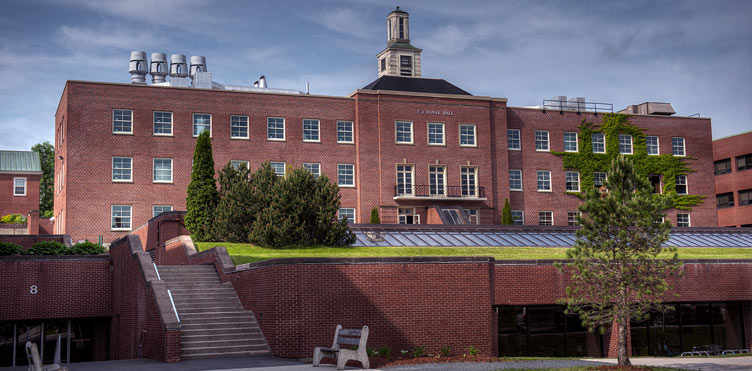Outreach

We take pride in our community involvement through our outreach programs, including:
- bringing high school students to our laboratories to perform experiments
- going to local high schools to help students with chemistry projects
-
going to local schools to perform chemistry demonstrations
Our outreach activities involve schools such as:
- Fredericton High School
- Leo Hayes High School
- Oromocto High School
- Southern Victoria High School
- McAdam High School
-
l’école Sainte-Anne
We have also had outreach activities with organizations like Science East.
Labs
We have two first-year chemistry labs that can accommodate fifty students, with a ventilation snorkel or a fume hood for every student.
The two upper-year chemistry labs provide full fume hoods for each student group due to the more intricate chemistry performed.
Lab coats, gloves and goggles are provided for each participant.
Common experiments performed
The Copper Cycle: Participants take a small sample of copper through various states differentiated by colour and solubility before reforming the original copper metal. This experiment demonstrates the importance of observations to understand the chemistry that is occurring during a reaction.
Polyprotic Titration: This titration of phosphoric acid relies on computer integrated pH electrodes and software that records and analyzes titration data. This experiment allows students to evaluate the quality of their data and then shows how the experimental data relates to parameters like concentration and pKa.
A growing outreach program
We enjoy developing new experiments in conjunction with teachers that will fit into their curriculum. This practice greatly expands students’ experimental experience by allowing students to use chemicals that are not normally available at their schools.
Members of the Department of Chemistry also perform demonstrations or groups, at Toole Hall or in the community.
Dr. Valerie Reeves and Dr. Sara Eisler regularly put on demonstrations such as Identify the Unknown, Diet Coke and Mentos Eruption, and Acid-Base Indicators for groups such as Worlds UNBound and Go-Go After School.
Dr. James Tait is a regular at Science East summer camps for Magic Potion demonstrations.
Are you interested in organizing an outreach event with the Department of Chemistry? Contact Dr. James Tait.
Outreach experiments
We are always developing new experiments for our outreach program. We are willing to work with teachers to develop curriculum-directed experiments.
School groups must have permission slips signed by the student’s guardians. These detail the experiment that the student will be performing and grant us permission to use photos from the events for promotional use. Contact us for a copy of the permission slip for the experiment you would like to perform.
Toxic Spill Investigation: These two experiments attempt to identify the cause of an increase in fish deaths in the Saint John River.
The Synthesis of Aso Dyes: These experiments are related to the synthesis of highly coloured organic molecules.
Frangrant Esters: A versatile synthesis of a variety of related molecules with different scents, ranging from fruit to perfume.
Synthesis of Indigo: A look into the history and synthetic preparation of the indigo dye used in colouring blue jeans.
Metallic Pigments: Not all useful dyes are organic compounds! This experiment looks at inorganic pigments based on cobalt.
The Copper Cycle: This involves a series of reactions that begin and end with copper. The experimental results are based on qualitative observations and involves techniques such as centrification. It covers chemical concepts like:
- simple substitution reactions
- formation of solids and gases
- reduction and oxidation reactions
The Copper Cycle can be performed by any high school student.
The Polyprotic Titration: This experiment involves the titration of a sample of dilute phosphoric acid, which is a triprotic acid. The titration uses our commercial software to quantitatively collect and analyze the pH versus titre volume data. It involves techniques such as using a burette to perform the titration and covers chemical concepts like determination of concentration and acid disassociation constant.
Outreach demonstrations
Members of our department are active in our community by performing chemistry demonstrations at schools and other organizations. Contact the Outreach Committee or James Tait (link to profile) for more information.
Outreach safety
Safety is our utmost concern at outreach events. Participants must wear appropriate clothing such as long pants, closed-toed shoes and other clothing that does not unnecessarily expose skin.
We provide laboratory coats, safety goggles and disposable nitrile gloves. We also give participants a safety talk before they perform the experiment.
- Contact us for more information about appropriate attire for the participants.
